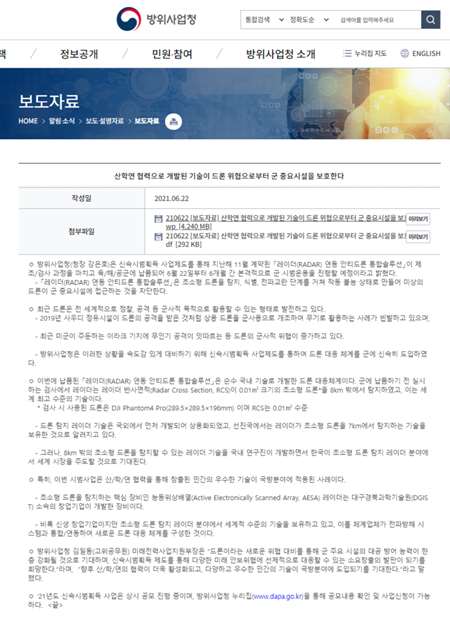
Offcial Website of DAPA: https://www.dapa.go.kr/dapa/main.do
The Defense Acquisition Program Administration (Chairman Kang-Eun-ho) announced that the “Radar-linked anti-drone integrated solution” contracted in November last year through the rapid trial acquisition project system completed the manufacturing/inspection process and was delivered to the Army/Navy/Air Force on June 22. From the date, he said that he plans to carry out the military pilot operation in earnest for six months.
-“Radar-linked anti-drone integrated solution” prevents unknown drones from approaching important military facilities by making them inoperable through detection, identification, and radio wave jamming stages.
Recently, drones have been developing into a form that can be used for military purposes such as reconnaissance and attack all over the world.
-Just as Saudi oil refineries were attacked by drones in 2019, there are frequent cases of commercial drones being converted for military use and used as weapons.
-Recently, the military threat of drone is increasing, such as drone attacks on Iraqi bases where US troops are stationed.
-The Defense Acquisition Program Administration (DAPA) quickly introduced a drone response system to the military through the rapid pilot acquisition project system to prepare for such a situation.
The “Radar-linked anti-drone integrated solution” delivered this time is a drone response system developed with pure domestic technology. In this inspection conducted before delivery to the military, the radar detected a micro drone* with a radar cross section (RCS) of 0.01m² from a distance of 8km, which is the world’s best technology.
*The drone used for inspection is a DJI Phantom 4 Pro (289.5×289.5x196mm) and RCS is 0.01m².
-The drone detection radar technology was first developed and commercialized abroad, and in developed countries, it is known that radar has the technology to detect micro drones at 7km.
-However, Korea is expected to lead the global market in the field of micro drone detection radar as a domestic research team develops a radar technology that can detect a micro drone from 8km away.
In particular, this pilot project is a case in which excellent private technology created through industry-academia-research collaboration is applied to the defense field.
–Active Electronically Scanned Array (AESA) radar, which is a key device for detecting micro drones, was developed by a startup company affiliated with Daegu Gyeongbuk Institute of Science and Technology (DGIST).
-Although it is a new start-up company, it has world-class technology in the field of micro drone detection radar, and the system company integrated/interworks with the jamming system to form a new drone response system.
Kim-Il-dong of the Defense Acquisition Program Administration (DAPA) said, “We expect that the anti-aircraft defense capabilities of major military facilities will be further strengthened by preparing for a new threat such as drones. I hope that it will become a stepping stone for creating demands that can be counteracted hostilely.” He said, “I hope that industry/academic/research cooperation will be further activated in the future, and various and excellent civilian technologies will be introduced into the defense field.”
The ’21 rapid trial acquisition project is open to the public at all times, and you can check the details of the competition and apply for the project through the website of the Defense Acquisition Program Administration (www.dapa.go.kr).
